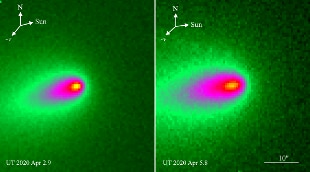ROME - The first to notice were astronomers Quanzhi Ye from the University of Maryland and Qicheng Zhang from the California Institute of Technology. A few hours later the confirmation came from the Liverpool Telescope of La Palma, on the Canary Islands: the nucleus of the highly anticipated comet C / 2019 Y4 ATLAS suddenly fragmented. For astronomy enthusiasts it is bad news: the hopes that it will become visible to the naked eye have narrowed. Broken in two Observations have shown that the nucleus has divided into at least two parts. Quanzhi Ye has published on Twitter the comparison between what it looked like on April 2 and what it looked like on April 5: its shape in the second image is different and more elongated, precisely because it broke. This also explains why the comet had been behaving abnormally for a few days: although it was getting closer to the Sun, it was not becoming brighter and, in fact, its brightness had even slightly decreased. <div style = "margin: 0 auto; text-align: center; width: 500px"> <blockquote class = "twitter-tweet"> <p lang = "en" dir = "ltr"> Dear fellow comet enthusiasts, we may have a bad news for you ... <a href="https://t.co/AqJsAcG0YC"> https://t.co/AqJsAcG0YC </a> <a href = "https: // t. co / lgaY6nEE1V "> pic.twitter.com/lgaY6nEE1V </a> </p> - Ye Quanzhi (叶 泉 志) (@Yeqzids) <a href =" https://twitter.com/Yeqzids/status/1247213473165008910?ref_src = twsrc% 5Etfw "> April 6, 2020 </a> </blockquote> <script async src =" https://platform.twitter.com/widgets.js "charset =" utf-8 "> </script> </div> Approaching the Sun fatal The comet ATLAS had been a special observation for some months, the potential astronomical event of the first half of 2020. Discovered in December, it seemed destined to become visible to the naked eye between the end of April and the beginning of May. Comets, however, are unpredictable, low-density bodies, and approaching the Sun is an extremely delicate moment. In this phase, the activity of the nucleus increases and the gases and dust that form the crown and tail are emitted. However, this weakens it and sooner or later, in many cases, triggers a process of disintegration that can prove to be even fatal. From big comet to big disappointment? From a potential Great Comet, will ATLAS become a major disappointment? It is currently located about 150 million kilometers from Earth and can be seen with telescopes and good binoculars in the Giraffe constellation. It still remains an elegant and fascinating object, but probably will not be able to keep up the expectations. Although nothing prevents us from hoping that it will give us an unexpected blow of the tail. Green, of course.
Share
by di Andrea Bettini 07 April 2020 ROME - The first to notice were astronomers Quanzhi Ye from the University of Maryland and Qicheng Zhang from the California Institute of Technology. A few hours later the confirmation came from the Liverpool Telescope of La Palma, on the Canary Islands: the nucleus of the highly anticipated comet C / 2019 Y4 ATLAS suddenly fragmented. For astronomy enthusiasts it is bad news: the hopes that it will become visible to the naked eye have narrowed. Broken in two Observations showed that the core was divided into at least two parts. Quanzhi Ye has published on Twitter the comparison between what it looked like on April 2 and what it looked like on April 5: its shape in the second image is different and more elongated, precisely because it broke. This also explains why the comet had been behaving abnormally for a few days: although it was getting closer to the Sun, it was not becoming brighter and, in fact, its brightness had even slightly decreased. Dear fellow comet enthusiasts, we may have a bad news for you ... https://t.co/AqJsAcG0YC pic.twitter.com/lgaY6nEE1V
- Ye Quanzhi (叶 泉 志) (@Yeqzids) April 6, 2020 The approach to the sun was fatal The ATLAS comet for some months had been a special observation, the potential astronomical event of the first half of 2020. Discovered in December, it seemed destined to become visible to the naked eye between the end of April and the beginning of May. Comets, however, are unpredictable, low-density bodies, and approaching the Sun is an extremely delicate moment. In this phase, the activity of the nucleus increases and the gases and dust that form the crown and tail are emitted. However, this weakens it and sooner or later, in many cases, triggers a process of disintegration that can prove to be even fatal. From big comet to big disappointment? From a potential Great Comet, will ATLAS become a major disappointment? It is currently located about 150 million kilometers from Earth and can be seen with telescopes and good binoculars in the Giraffe constellation. It still remains an elegant and fascinating object, but probably will not be able to keep up the expectations. Although nothing prevents us from hoping that it will give us an unexpected blow of the tail. Green, of course.

